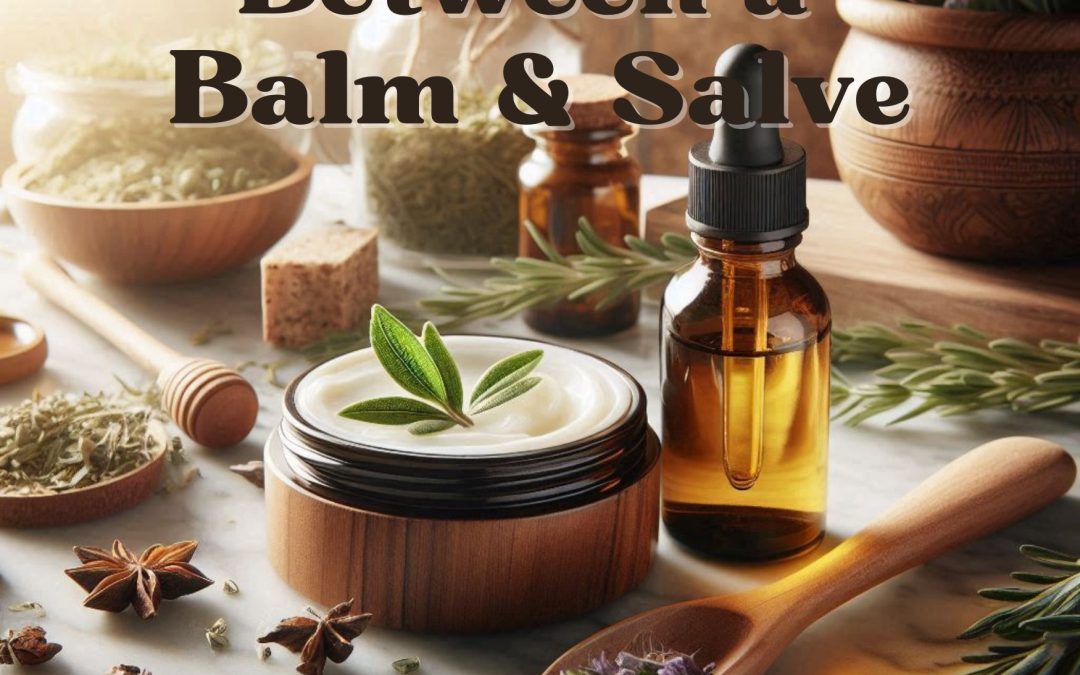This post may contain affiliate links, to learn more about them, check out our Disclosure.
When it comes to natural remedies, balms and salves are popular choices for soothing the skin, relieving pain, and promoting healing. While these terms are often used interchangeably, they have distinct differences. In this article, we’ll explore the key differences between balms and salves and provide a basic ratio recipe to help you create your own.
What is a Balm?
Consistency and Texture:
Balms are typically thicker and more solid compared to salves. This is due to the higher concentration of beeswax or other solidifying agents used in the formula. The thicker consistency makes balms ideal for targeted application on specific areas, such as dry skin patches, cracked lips, or sore muscles.
Purpose and Usage:
Balms are often used for their protective and moisturizing properties. They create a barrier on the skin, which helps lock in moisture and protect against environmental elements. Balms are commonly used for:
- Lip care (lip balms)
- Healing cracked skin
- Soothing sore muscles
- Protecting the skin from wind and cold
What is a Salve?
Consistency and Texture:
Salves have a softer, more spreadable consistency compared to balms. They contain less beeswax and more liquid oils, making them easier to apply over larger areas of the skin. Salves are often more oily or greasy due to the higher oil content.
Purpose and Usage:
Salves are primarily used for healing and soothing purposes. They are infused with herbs or essential oils that offer specific therapeutic benefits, such as reducing inflammation, promoting wound healing, or relieving pain. Salves are commonly used for:
- Treating cuts, scrapes, and burns
- Alleviating muscle aches and joint pain
- Soothing irritated or inflamed skin
- Healing minor wounds
Key Differences Between Balm and Salve
Consistency:
- Balm: Thicker, more solid, and less oily.
- Salve: Softer, more spreadable, and oilier.
Beeswax Ratio:
- Balm: Higher beeswax content for a firmer texture.
- Salve: Lower beeswax content for a softer consistency.
Purpose:
- Balm: Protective, moisturizing, and targeted application.
- Salve: Healing, soothing, and broader application.
Basic Ratio Recipe for Balm and Salve
Creating your own balm or salve is simple, and the key lies in adjusting the ratio of beeswax to carrier oils. Here’s a basic recipe to get you started:
Ingredients:
- Carrier Oil (e.g., olive oil, coconut oil, jojoba oil): 1 cup
- Beeswax (grated or pellets):
- For Balm: 1/4 to 1/2 cup
- For Salve: 2 to 3 tablespoons
- Essential Oils (optional): 15-30 drops
- Herbs (optional): 1/4 cup (infuse into carrier oil beforehand)
Instructions:
- In a double boiler or a heat-safe bowl over a pot of simmering water, melt the beeswax.
- Once the beeswax is melted, add the carrier oil and stir until fully combined. For a balm, use a higher amount of beeswax for a thicker consistency. For a salve, use less beeswax for a softer texture.
- Remove the mixture from heat and allow it to cool slightly. Stir in the essential oils if desired.
- Pour the mixture into clean containers, such as tins or jars. Allow it to cool and solidify at room temperature.
- Once solidified, label your balm or salve and store it in a cool, dry place.
Understanding the differences between balms and salves can help you choose the right product for your needs, whether you’re looking to protect your skin or soothe aches and pains. By following the basic ratio recipe provided, you can also create your own customized balm or salve at home, tailored to your specific preferences and needs.
Want to see how we make our balms and salves? Be sure to check out our YouTube Channel! Be sure to check out our DIY Soap area to learn more!

